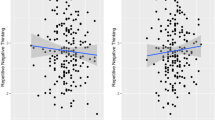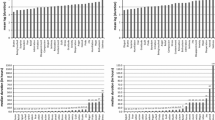Abstract
Based on an earlier model of the processes elicited by surprising events, the present studies provide evidence for one of these processes, the evaluation of the surprising event's relevance for ongoing activities (action-relevance check). The central prediction tested was that, if unexpected events elicit among other processes an action-relevance check, then response delay on a concurrent task will be more pronounced in a condition where this process is more elaborate and hence takes more time. In accord with this prediction, Experiment 1 found that an unexpected appearance change of the imperative stimulus in a choice reaction time (RT) task caused greater response delay than an equivalent appearance change of a distractor stimulus. Experiment 2 replicated this finding and tested several additional predictions that concerned the effects on response delay of a second appearance change of either the imperative or the distractor stimuli. These predictions, which were also mostly confirmed, were derived by combining the logic underlying the first study with the assumption that once made, appraisals of unexpected events are stored as part of the situational schema and are reused when the same or similar events reoccur leading to an abbreviation of appraisal processes. Experiment 3 once more replicated the basic finding of the previous studies and ruled out a possible alternative explanation. It is suggested that the proposed RT method of process verification may be of broader interest as a tool to study appraisal processes in emotion.
Similar content being viewed by others
REFERENCES
Fazio, R. H. (1990). A practical guide to the use of response latency in social psychological research. In C. Hendrick & M. S. Clark (eds.), Research methods in personality and social psychology (pp. 74–97). Newbury Park, CA: Sage.
Frijda, N. H. (1986). The emotions. Cambridge, England: Cambridge University Press.
Frijda, N. H. (1993). The place of appraisal in emotion. Cognition and Emotion, 7, 357–387.
Frijda, N. H., Kuipers, P., & ter Schure, E. (1989). Relations among emotion, appraisal, and emotional action readiness. Journal of Personality and Social Psychology, 57, 212–228.
Lazarus, R. S. (1995). Vexing research problems inherent in cognitive-mediational theories of emotion—and some solutions. Psychological Inquiry, 6, 183–196.
Logan, G. D. (1988). Toward an instance theory of automatization. Psychological Review, 95, 492–527.
Mandler, G. (1984). Mind and body. New York: W. W. Norton & Company.
Meyer, W.-U. (1988). Die Rolle von Überraschung im Attributionsprozess [The role of surprise in the attribution process]. Psychologische Rundschau, 39, 136–147.
Meyer, W.-U., & Niepel, M. (1994). Surprise. In V. S. Ramachandran (ed.), Encyclopedia of human behavior (Vol. 4, pp. 353–358). Orlando, FL: Academic Press.
Meyer, W.-U., Niepel, M., Rudolph, U., & Schützwohl, A. (1991). An experimental analysis of surprise. Cognition and Emotion, 5, 295–311.
Meyer, W.-U., Niepel, M., & Schützwohl, A. (1994). Überraschung und Attribution [Surprise and attribution]. In F. Försterling & J. Stiensmeier-Pelster (eds.), Attributionstheorie. Grundlagen und Anwendungen (pp. 105–121). Göttingen: Hogrefe.
Meyer, W.-U., Reisenzein, R., & Schützwohl, A. (1995). A model of processes elicited by surprising events. Unpublished manuscript, University of Bielefeld, Germany.
Niepel, M., Rudolph, U., Schützwohl, A., & Meyer, W.-U. (1994). Temporal characteristics of the surprise reaction induced by schema-discrepant visual and auditory events. Cognition and Emotion, 8, 433–452.
Ortony, A., Clore, G. L., & Collins, A. (1988). The cognitive structure of emotions. New York: Cambridge University Press.
Parkinson, B., & Manstead, A. S. R. (1992). Appraisal as a cause of emotion. In M. S. Clark (ed.), Review of Personality and Social Psychology (Vol. 13, pp. 122–149). New York: Sage.
Reisenzein, R. (1997). Exploring the association among cognitive, experiential, behavioral, and expressive components of emotion syndromes: The case of surprise. Unpublished manuscript, University of Bielefeld, Germany.
Reisenzein, R., Meyer, W.-U., & Schützwohl, A. (1996). Reactions to surprising events: A paradigm for emotion research. In N. H. Frijda (ed.), Proceedings of the 9th conference of the International Society for Research on Emotions (pp. 292–296). Toronto: ISRE.
Reisenzein, R., & Spielhofer, C. (1994). Subjectively salient dimensions of emotional appraisal. Motivation and Emotion, 18, 1–47.
Roseman, I. J. (1984). Cognitive determinants of emotion: A structural theory. In P. Shaver (ed.), Review of personality and social psychology (Vol. 5, pp. 11–36). Beverly Hills, CA: Sage.
Roseman, I. J. (1991). Appraisal determinants of discrete emotions. Cognition and Emotion, 5, 161–200.
Rumelhart, D. E. (1984). Schemata and the cognitive system. In R. S. Wyer, Jr. & T. K. Srull (eds.), Handbook of social cognition (Vol. 1, pp. 161–188). Hillsdale, NJ: Erlbaum.
Scherer, K. R. (1984). On the nature and function of emotion: A component process approach. In K. R. Scherer & P. Ekman (eds.), Approaches to emotion (pp. 293–317). Hillsdale, NJ: Erlbaum.
Scherer, K. R. (1993). Studying the emotion-antecedent appraisal process: An expert system approach. Cognition and Emotion, 7, 325–355.
Schützwohl, A. (1993). Schema und Überraschung [Schema and surprise]. Unpublished doctoral dissertation, University of Bielefeld.
Smith, C. A., & Ellsworth, P. C. (1985). Patterns of cognitive appraisal in emotion. Journal of Personality and Social Psychology, 48, 813–838.
Smith, C. A., & Lazarus, R. S. (1990). Emotion and adaptation. In L. Pervin (ed.), Handbook of personality: Theory and research (pp. 609–637). New York: Guilford.
Stiensmeier-Pelster, J., Martini, A., & Reisenzein, R. (1995). The role of surprise in the attribution process. Cognition and Emotion, 9, 5–31.
Taylor, S. E., & Crocker, J. (1981). Schematic basis of social information processing. In E. T. Higgins, C. P. Herman, & M. P. Zanna (eds.), Social cognition: The Ontario symposium on personality and social psychology (pp. 89–134). Hillsdale, NJ: Erlbaum.
Tooby, J., & Cosmides, L. (1990). The past explains the present: Emotional adaptations and the structure of ancestral environments. Ethology and Sociobiology, 11, 375–424.
Weiner, B. (1986). An attributional theory of motivation and emotion. New York: Springer-Verlag.
Weiner, B., Perry, R. P., & Magnusson, J. (1988). An attributional analysis of reactions to stigmas. Journal of Personality and Social Psychology, 55, 738–748.
Author information
Authors and Affiliations
Rights and permissions
About this article
Cite this article
Meyer, WU., Reisenzein, R. & Schützwohl, A. Toward a Process Analysis of Emotions: The Case of Surprise. Motivation and Emotion 21, 251–274 (1997). https://doi.org/10.1023/A:1024422330338
Issue Date:
DOI: https://doi.org/10.1023/A:1024422330338




